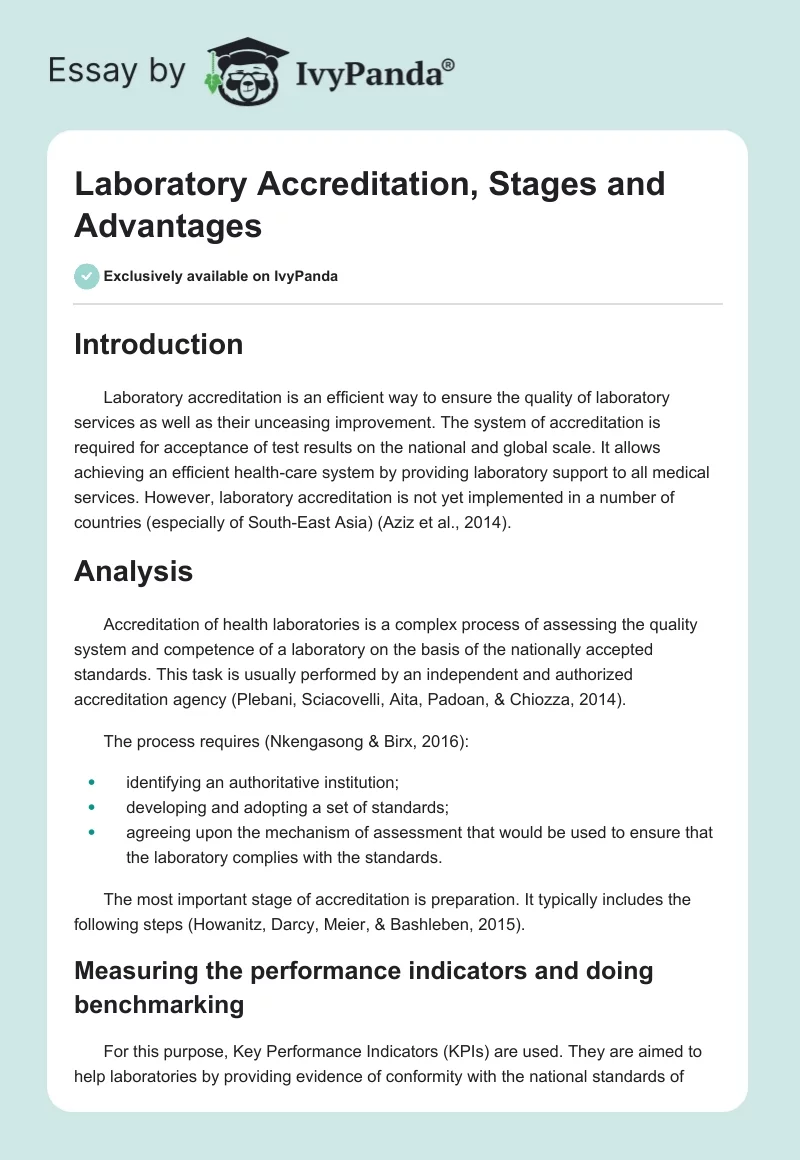Introduction
Laboratory accreditation is an efficient way to ensure the quality of laboratory services as well as their unceasing improvement. The system of accreditation is required for acceptance of test results on the national and global scale. It allows achieving an efficient health-care system by providing laboratory support to all medical services. However, laboratory accreditation is not yet implemented in a number of countries (especially of South-East Asia) (Aziz et al., 2014).
Analysis
Accreditation of health laboratories is a complex process of assessing the quality system and competence of a laboratory on the basis of the nationally accepted standards. This task is usually performed by an independent and authorized accreditation agency (Plebani, Sciacovelli, Aita, Padoan, & Chiozza, 2014).
The process requires (Nkengasong & Birx, 2016):
- identifying an authoritative institution;
- developing and adopting a set of standards;
- agreeing upon the mechanism of assessment that would be used to ensure that the laboratory complies with the standards.
The most important stage of accreditation is preparation. It typically includes the following steps (Howanitz, Darcy, Meier, & Bashleben, 2015).
Measuring the performance indicators and doing benchmarking
For this purpose, Key Performance Indicators (KPIs) are used. They are aimed to help laboratories by providing evidence of conformity with the national standards of accreditation. The suggested indicators of laboratory performance are regularly reviewed in order to ensure that they answer all the requirements advanced by the modern clinical laboratory practice. The laboratory must demonstrate competency of staff, high-quality training and education, a wide repertoire of tests as well as the integrity of reporting test results, engagement with patients and users, successful teamwork, timeliness of reports, and external quality assurance.
The internal and external auditing
The laboratory needs information obtained by an audit to make it clear how it is currently performing in terms of quality management and conclude what changes have to be introduced and what faults must be amended before submitting an application for accreditation. Internal auditing is performed in-house and implies that the staff working in one area of the laboratory should conduct assessments of another area in order to understand how well other staff members comply with accreditation requirements. During external auditing, agencies from the outside come to the laboratory and perform examinations. The information that must be collected includes the quality of operating procedures, staff competence, equipment, environment, handling of samples, verification of results, and level of reporting practices.
Selection of the accrediting body
It is essential that accreditation is performed by a professional agency. The laboratory must make sure that the accrediting body fully complies with the international standard ISO/IEC 17011, which sets the requirement for accreditation bodies that have the right to assess the conformity of laboratories with quality standards. Only in this case, the accrediting agency can be given access to the laboratory in order to perform necessary tests.
Submitting an application
Only after all the above-mentioned steps are performed, the laboratory can apply for accreditation.
Accreditation is granted to the laboratory for two years. After the initial year of accreditation, the laboratory has to pay annual fees and assessor fees in order to undergo a surveillance visit performed to confirm that the management system and technical provision of the laboratory remain in total compliance with the standards. If the laboratory fails to comply, adverse accreditation usually takes place (Plebani, 2016).
Conclusion
Accreditation of laboratories has a number of evident advantages including independent validation of the laboratory’s quality standards for management, procedures, and equipment, exemption from surveys by state survey agencies, established standards guiding practice, prestigious position among other clinical laboratories, etc. However, it also features certain disadvantages, such as high costs, time-consuming process of preparation, surveillance visits threatening with an adverse accreditation action, and the obligatory accreditation renewal (Long-Mira, Washetine, & Hofman, 2016).
In order to make this process more affordable and successful, the government must provide more benefits and guarantees to accredited laboratories and decrease accreditation fees. This would make accreditation more attractive and worthwhile.
References
Aziz, N., Zhao, Q., Bry, L., Driscoll, D. K., Funke, B., Gibson, J. S.,… & Merker, J. D. (2014). College of American Pathologists’ laboratory standards for next-generation sequencing clinical tests. Archives of Pathology and Laboratory Medicine, 139(4), 481-493.
Howanitz, P. J., Darcy, T. P., Meier, F. A., & Bashleben, C. P. (2015). Assessing clinical laboratory quality: A College of American pathologists Q-Probes study of prothrombin time INR structures, processes, and outcomes in 98 laboratories. Archives of Pathology and Laboratory Medicine, 139(9), 1108-1114.
Long-Mira, E., Washetine, K., & Hofman, P. (2016). Sense and nonsense in the process of accreditation of a pathology laboratory. Virchows Archive, 468(1), 43-49.
Nkengasong, J. N., & Birx, D. (2016). Quality matters in strengthening global laboratory medicine: commentary. African Journal of Laboratory Medicine, 3(2), 1-4.
Plebani, M. (2016). Harmonization in laboratory medicine: Requests, samples, measurements and reports. Critical Reviews in Clinical Laboratory Sciences, 53(3), 184-196.
Plebani, M., Sciacovelli, L., Aita, A., Padoan, A., & Chiozza, M. L. (2014). Quality indicators to detect pre-analytical errors in laboratory testing. Clinica Chimica Acta, 432(1), 44-48.


